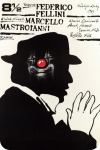Charlize Theron stars as Mavis Gary, a wicked wreck of a former prom queen determined to reclaim the affections of her high school boyfriend--who has actually managed to become an adult during the last 20 years. Theron is divinely wretched here as a stunted queen bee in search of a hive, and Patton Oswalt is resolutely great as a caustic former outcast who is once again ensnared by Mavis’s deranged, indomitable will. This one was overlooked and unloved upon its release, mostly because it's a Diablo Cody/Jason Reitman production, and people were hoping for Juno at 37. What they got was a bleak, sharp, courageous examination of social dynamics, mental illness, and the ways in which new societal norms contribute to arrested development. And, you must trust me, this is just so much better.
MOVIES, MUSIC
Young Adult
Jason Reitman / 2011

Searching for Sugar Man
Malik Bendjelloul / 2012

Two fans want to find out what happened to an enigmatic singer whose message of peace and love inspired South Africa during its darkest days of apartheid. Their hunt ends in Detroit, where the troubadour has carried on as a serene, soft-spoken construction worker. Though it could have dug deeper, Searching for Sugar Man is a rather sweet celebration of the power of
music and the magic of life’s surprises.
The Godfather: Part III
Francis Ford Coppola / 1990

From the inane dialogue to the insipid details (the “$100 million” donation to…Sicily), this was a puzzlingly stupid film, not to mention an insulting conclusion to a beautiful saga.
I would even go so far as to say that it’s somewhat awesome in its inferiority. How is it possible that Francis Ford Coppola directed this? How is it that the highly talented Sofia gave the most mind-achingly vapid and distracting performance in memory? How do you turn Pacino’s intensity into a weariness somewhere between apathy and inattention? How has Andy Garcia coped with hosting the South Pacific hut that is his chest hair?
There are a lot of bad movies and a lot of bad sequels, but this one is uniquely demoralizing. It made me question how I could have been so taken with the original and why I ultimately gave the second one the benefit of the doubt. It made me question the influence of wealth and fame upon ambition and neurological capabilities. It made me wonder how the apparently oppressive studio maneuvers that surrounded The Godfather in 1972 had evolved so as to produce this gaudy, gilded-by-Trump flatulence eighteen years later.
The Godfather and The Godfather: Part II
Francis Ford Coppola / 1972 & 1974

The Godfather wears its genius effortlessly—the best (and only?) way to wear it. It’s a triumph of restraint punctuated by self-possessed bombast. It’s a marvel of pacing, with the tension escalating amid a series of elegantly wrenching surprises. There’s Marlon; and there are Al’s exquisite eyes and bearing. Plus, it’s just a lot of fun.
Fittingly, The Godfather: Part II starts off in a tailspin. Without Marlon as Vito to guide its course with his majestic oddities, it fumbles with overly obvious dialogue, bludgeoning Hollywood sound cues, and a general sense of fecklessness. Though Pacino presides over all the double-crossings, crooked senators and, y’know, a Cuban Revolution with a commanding, tightly controlled ferocity, it takes a very long time for it to become something other than the excessive audiovisual version of “99 Problems.” There’s Michael again: alone, annoyed, and disappointed in yet another weak family member or associate.
But something happened during the last scene. Flashback: Sonny, Connie, and Michael are waiting for Pops, who’s off Christmas shopping (wouldn’t you know?). Connie is taken with her future husband and torturer, Sonny is psychotic, and Michael is an idealistic collegiate. It was only here that the sense of doom and loss that permeated the film was sensitized. It was only here—with Michael given a complementary figure to spur the action—that there was enough of a dynamic to incite a visceral reaction. Without the push and pull of his family’s major players, Michael’s sad soliloquy is barren, lugubrious, and a little shallow. Within this context, the texture of his individuation and strength within the tragic pride of his family fascinates.








